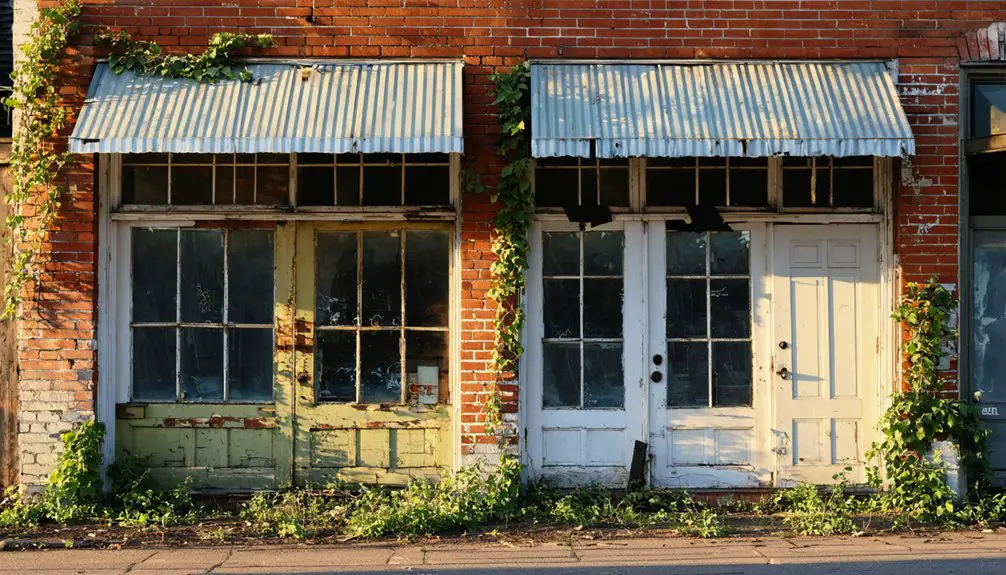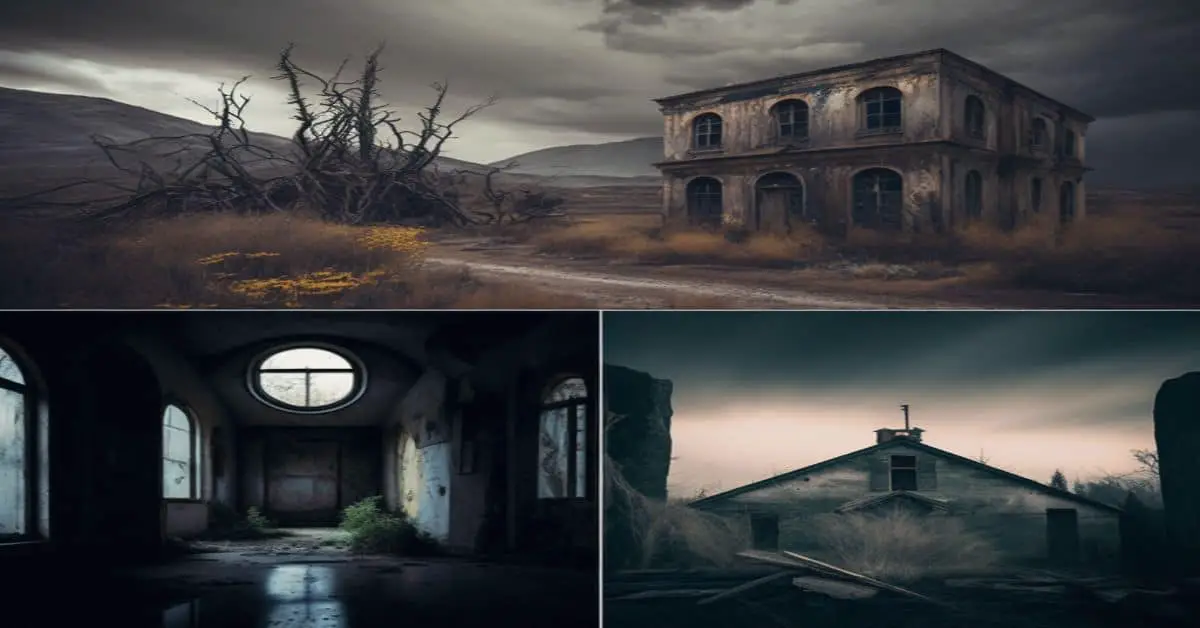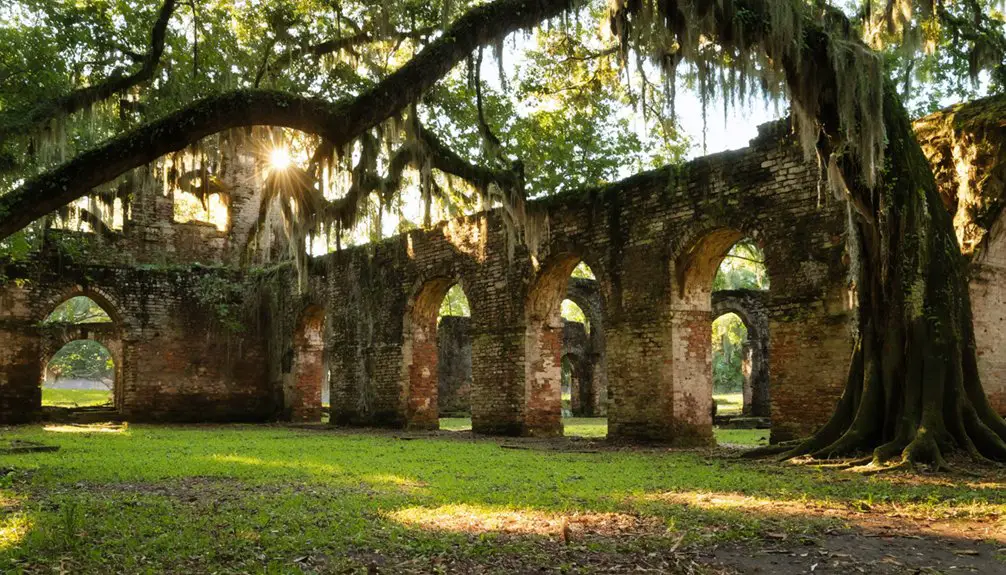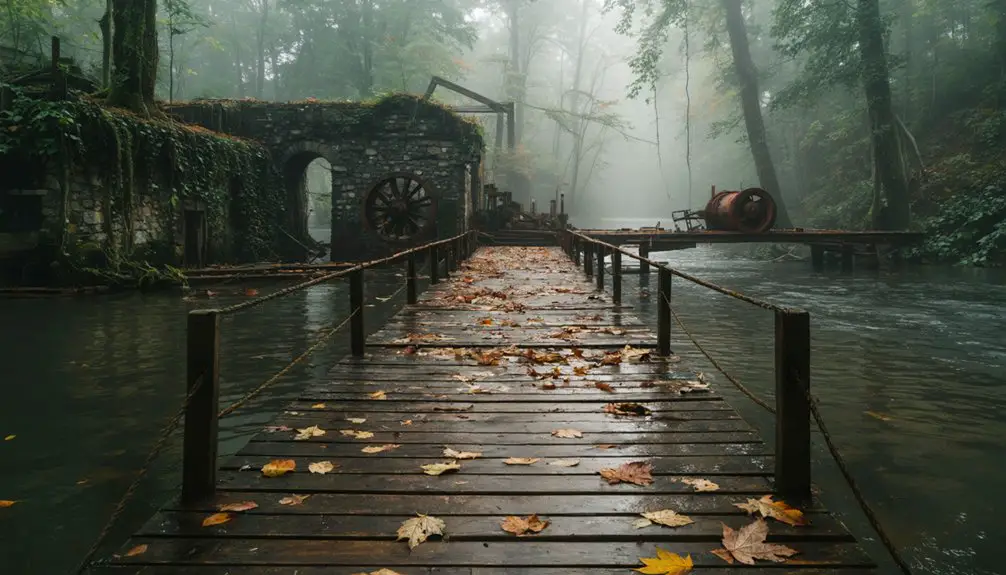You’ll find Browntown’s haunting ruins nestled in Davidson County’s foothills, where it once thrived as a bustling mid-1700s settlement. The town’s fortunes changed dramatically during Prohibition when federal raids targeted its flourishing moonshine operations. After the railroads bypassed the area and natural disasters struck, residents abandoned their homes for rail-connected communities. Today, over 40 life-sized replica buildings, including saloons, a church, and a jail, stand as silent witnesses to Browntown’s tumultuous past.
Key Takeaways
- Browntown was a thriving mid-1700s settlement in Davidson County that declined after railroads bypassed the town and natural disasters struck.
- Over 40 life-size replica buildings remain on Buck Mountain, including saloons, a church, school, bank, and jail.
- Federal raids during Prohibition targeting moonshine operations accelerated the town’s economic decline and population loss.
- Archaeological discoveries since 1900 have revealed colonial artifacts, including a 1760s tavern and Native American burial sites.
- The Browntown Preservation Society works to protect the ghost town’s heritage through building restoration and historical documentation.
The Rise of a Moonshine Empire
While North Carolina’s moonshine history spans centuries, its most dramatic rise occurred during the Prohibition era of the 1920s and 1930s. You’d find moonshine production thriving in the remote mountain coves and eastern swamps, where dedicated moonshiners crafted their potent spirits under the cover of darkness.
In these isolated communities, moonshine became more than just illegal whiskey – it represented both rebellion and survival. As part of Appalachian culture, distilling helped sustain mountain economies when legitimate work was scarce. Located in this region, Wilkes County emerged as the undisputed moonshine capital of the world. The whiskey tax of 1791 had originally sparked resistance among small-scale distillers who sought to protect their livelihoods.
Moonshiners used copper stills to transform corn mash into high-proof liquor, reaching alcohol contents of up to 150 proof. You’d hear them called by various names: mountain dew, white lightning, or stumphole whiskey.
Despite the constant threat of raids from revenuers, the trade flourished, creating a complex network of producers, bootleggers, and runners.
From Logging Town to Ghost Town
As railroads carved new paths through North Carolina in the mid-19th century, Browntown’s fate took a devastating turn.
The relentless march of railroad progress bypassed Browntown, sealing its destiny as another forgotten crossroads in North Carolina’s landscape.
You’d have seen the town’s bustling trade routes become obsolete when railroad companies chose to bypass the settlement, leaving its logging history and agricultural commerce stranded without efficient transportation.
Natural disasters struck mercilessly at Browntown’s weakened infrastructure, while the town’s isolation from new transport networks pushed businesses and residents toward thriving rail-connected communities like High Point. In its heyday, the town had been home to six notable doctors who served the thriving population. A professor named Don Taylor would later share the origin stories of this forgotten community.
The exodus accelerated as floods and fires ravaged what remained of the once-prosperous settlement.
Today, you’ll find only ruins where this vibrant community once stood – a ghost town that serves as a stark reminder of how quickly fortunes can change when progress takes an alternate route.
Federal Raids and Economic Collapse
During Prohibition, you’d find moonshine stills tucked away in Browntown’s dense forests, where local bootleggers operated a profitable underground liquor trade.
Federal raids intensified throughout 1926-1928 as revenue agents targeted the area’s illicit operations, confiscating equipment and arresting several prominent distillers. The raids were reminiscent of the famous Harpers Ferry raid that targeted another underground operation decades earlier. Like the historic operation where U.S. Marines led the assault, federal agents methodically planned their raids on the moonshine operations.
The enforcement campaign dealt a severe economic blow to Browntown’s remaining residents, many of whom had turned to moonshining after the decline of the logging industry.
Moonshine Operations Under Fire
Because federal agents intensified their campaign against illegal distilleries in North Carolina, moonshine operations faced unprecedented pressure in the early 20th century.
You’d find revenue agents using innovative tactics like spiking roads with nails and deploying confiscated cars to chase down bootleggers. The moonshine culture remained resilient, though, as bootlegger tactics evolved to counter enforcement efforts. They’d use their intimate knowledge of mountain terrain and high-speed driving skills to evade capture. Wilkes County emerged as the epicenter of moonshine production and distribution during this period. North Carolina went dry statewide in 1909, making illegal production even more prevalent.
Despite aggressive raids by federal posses, many moonshiners maintained surprisingly cordial relationships with law enforcement.
You’d see operators like Amos Owens choosing to entertain agents rather than flee. Even with regular seizures of stills and vehicles, the scale of operations meant many bootleggers could absorb losses while still turning healthy profits.
Impact of Prohibition Enforcement
Federal raids on Browntown’s moonshine operations marked the beginning of the community’s devastating economic decline. You’d find federal agents ruthlessly targeting distilleries, confiscating equipment, and arresting local producers who’d provided essential income for countless families since the Civil War era. Similar to Buffalo City’s overnight raid, the enforcement actions dealt a swift and irreversible blow to the local moonshine trade.
The area experienced economic instability like Ghost Town in the Sky, which saw visitor numbers plummet from 620,000 to 340,000 annually.
As moonshine revenue dried up, you could watch Browntown’s entire economic framework crumble. Businesses dependent on liquor profits closed their doors, while the lack of economic diversification left the town with no alternative industries.
The raids shattered community cohesion as families fled to escape federal scrutiny and financial ruin. Schools and medical practices suffered from dwindling populations and reduced funding.
What remained was a shell of a once-thriving town, its abandoned buildings standing as stark reminders of how Prohibition enforcement destroyed a way of life.
Life in Early Browntown
As settlers moved into North Carolina’s backcountry in the mid-1700s, Browntown emerged as one of Davidson County‘s largest settlements, rivaling both Salisbury and Charlotte in size.
You’d find a diverse mix of English, Scotch-Irish, and German settlers, including Moravians, who’d established a vibrant community along Abbotts Creek.
The settler lifestyle centered around farming the fertile creek lands and practicing skilled trades, particularly cabinet-making.
Community gatherings at local churches strengthened social bonds among residents.
You’d see craftsmen’s shops and homes clustered in the town center, while trade routes connected you to regional markets.
The town’s strategic location on the road between Salisbury and Guilford Court House made it a hub of activity, though this prominence wouldn’t last as new transportation routes bypassed the settlement.
Historical Remnants and Local Legends
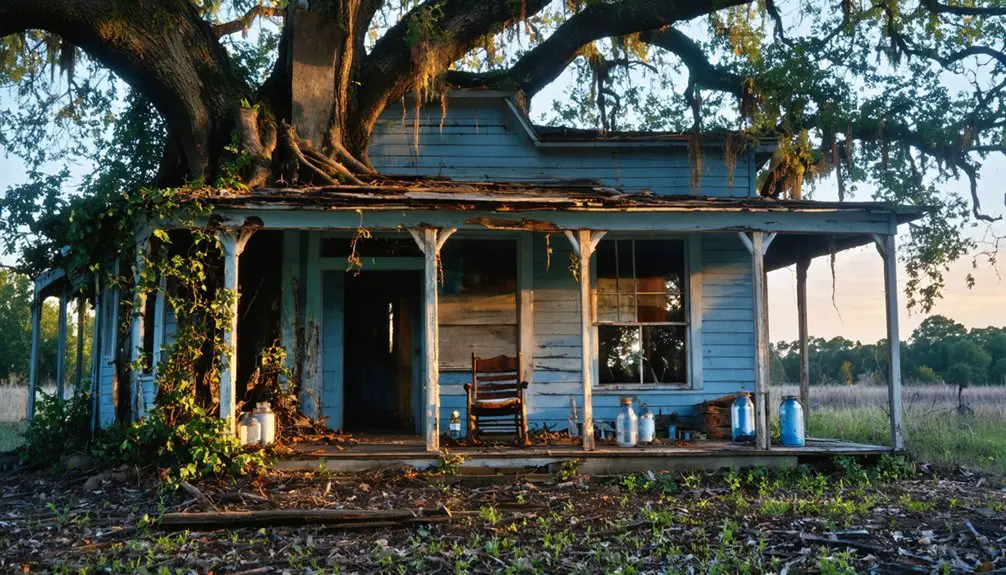
As you explore Browntown’s ruins today, you’ll find abandoned structures and the preserved old schoolhouse maintained by the Browntown Preservation Society standing as monuments to its 19th-century prominence.
Local legends about moonshine operations persist through oral histories passed down by descendants of original settlers, though these tales remain largely unverified.
Archaeological surveys since 1900 have uncovered period-specific artifacts scattered throughout the area, including farm implements and household items that offer glimpses into daily life during the town’s heyday.
Physical Traces Today
The ghostly remnants of Browntown stand as silent witnesses to its former glory, with over 40 life-size replica buildings still partially standing on Buck Mountain’s flattened summit.
Despite decades of physical decay, you’ll find recognizable facades of the Old West town’s core structures marking their historical significance, including weathered saloons, a church, school, bank, and jail.
- Deteriorating wooden frameworks and roofing materials tell the story of abandonment
- Overgrown paths and old roadbeds outline former connections between buildings
- The incline railway’s track framework remains partially visible, though deteriorated
- Natural erosion and encroaching vegetation have reshaped the mountain landscape
- Scattered artifacts like nails, boards, and metal fragments hint at the town’s past construction
The Browntown Preservation Society works to stabilize these remaining structures, ensuring these physical traces continue telling their tale of frontier ambition.
Moonshine Tales Persist
Deep within Buck Mountain’s remote coves and hidden hollows, moonshine legends still echo from Browntown’s Prohibition-era past.
You’ll hear tales of enterprising locals who crafted “white lightning” from corn harvests, following recipes passed down through generations. These moonshine folklore stories reveal the Appalachian resilience of families who turned to distilling as a means of economic survival.
Local accounts tell of ingenious moonshiners like Lewis Redmond and Hiram Wilson, who mastered Native American tactics to elude revenue officers.
The community’s intricate network of producers, runners, and bootleggers operated in secrecy, connecting Browntown’s remote stills to distant urban markets.
Today, while the stills have long gone cold, the stories of quick-witted moonshiners and their cat-and-mouse games with “revenuers” remain deeply woven into Browntown’s cultural fabric.
Archaeological Discoveries Since 1900
Since archaeological excavations began in 1900, Browntown’s hidden treasures have painted a rich historical canvas spanning multiple cultures and eras.
Archaeological findings reveal the complex layers of America’s struggle for independence and native heritage, with colonial artifacts telling stories of both peaceful trade and violent conflict. You’ll find evidence of life ranging from prehistoric woodland settlements to revolutionary-era structures.
- A previously unknown colonial tavern discovered in 2018, containing pristine 1760s artifacts including wine taps and tobacco pipes
- Native American burial sites with flexed-position skeletons and hunting tools dating back to 1000 BCE
- Stone foundations of colonial homes at “Nath Moore’s Front” showing signs of 1770s revolutionary destruction
- Defensive earthworks and military structures documenting colonial resistance to British rule
- Early Cape Fear Indian settlements predating European contact, with evidence of devastating smallpox impact
Preserving Browntown’s Legacy
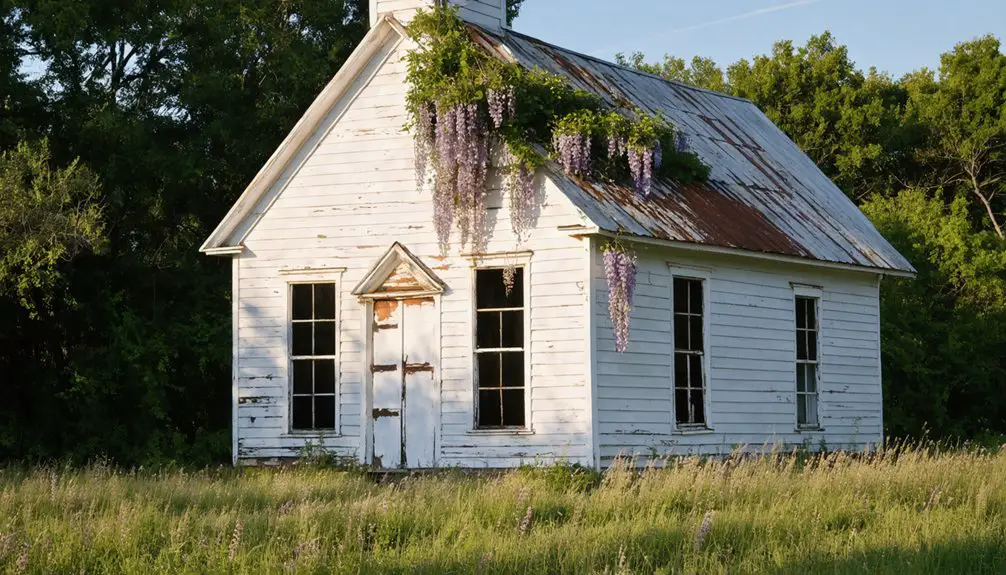
As Browntown’s historic structures faced mounting threats from natural disasters and economic decline, dedicated preservationists established the Browntown Preservation Society to protect the town’s irreplaceable heritage.
Today, you’ll find community involvement at the heart of preservation efforts, with volunteers working to restore key buildings like the original schoolhouse while battling ongoing preservation challenges such as limited funding and deteriorating structures.
The Society’s work extends beyond physical restoration, employing modern technology like 3D scanning to document historic sites and developing educational programs that connect students with their local heritage.
Through partnerships with regional tourism boards, grant applications, and fundraising events, they’re securing the resources needed to safeguard Browntown’s legacy for future generations to explore and appreciate.
Frequently Asked Questions
Are There Any Remaining Structures Still Standing in Browntown Today?
You’ll find several remaining buildings still standing, including the Old West Street’s saloon and church, with their original furnishings preserved inside, though they’ve weathered years of historical preservation challenges.
Can Visitors Legally Explore the Former Town Site?
You’ll need to verify legal permissions and follow exploration guidelines through the Browntown Preservation Society, as mixed property ownership and safety concerns restrict unauthorized access to most of the site.
What Happened to the Families Who Lived There After Leaving?
Ever wonder about those who left? You’ll find their family migrations led to Salem and western NC towns, while many descendants maintain legacy stories through preservation work and annual heritage events.
Were There Any Churches or Schools in Browntown?
You’ll find evidence of a preserved schoolhouse in Browntown’s school legacy, but church history remains unclear – though similar towns typically had churches, there’s no direct proof of their existence.
Did Any Native American Tribes Live in the Area Before Browntown?
Yes, the Tuscarora tribe primarily inhabited your area, shaping tribal influence along the Neuse and Pamlico Rivers. Archaeological evidence shows they’d lived there for thousands of years before European settlement.
References
- https://www.onlyinyourstate.com/experiences/north-carolina/nc-ghost-towns
- https://en.wikipedia.org/wiki/Ghost_Town_Village
- https://www.youtube.com/watch?v=V7y7UvMeKr8
- https://www.romanticasheville.com/ghost_town.htm
- https://www.youtube.com/watch?v=2NuGJTg9LBs
- https://www.ncpedia.org/moonshine
- https://moonshiner28.com/moonshiner-history/
- https://www.youtube.com/watch?v=gAI7YLFjyvE
- https://phototravelwrite.com/uncovering-the-rich-history-of-moonshine-in-benson-north-carolina/
- https://moonrunnerssaloon.com/5-fascinating-facts-about-moonshines-history-in-north-carolina/
